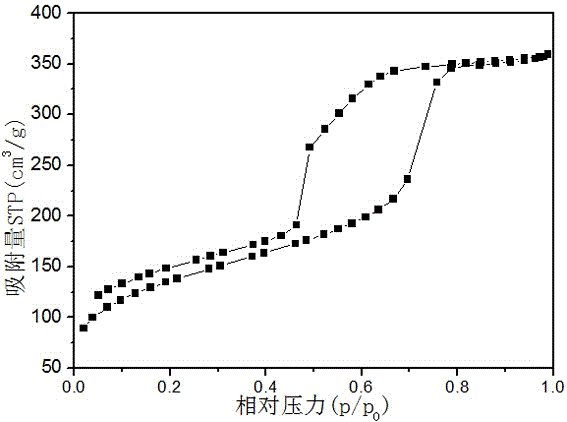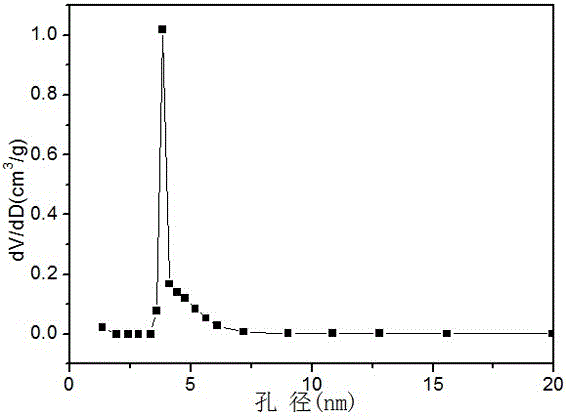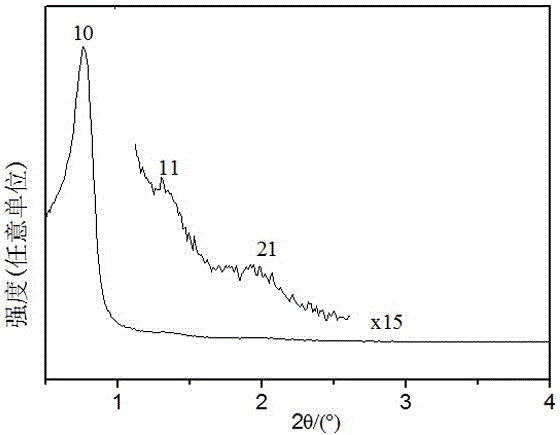Resin-based immobilized rhodium-phosphine complex catalyst as well as preparation method and application of catalyst
A technology of rhodium complexes and catalysts, which is applied in the field of resin-based immobilized rhodium-phosphine complex catalysts and their preparation, can solve the problems of poor catalytic effect, low activity, gaps, etc., achieve high selectivity, improve catalytic activity, reduce Effects of rhodium loss
- Summary
- Abstract
- Description
- Claims
- Application Information
AI Technical Summary
Problems solved by technology
Method used
Image
Examples
Embodiment 1
[0029] 1. Synthesis of phenolic resin
[0030] 1) Weigh 2.44g of phenol, melt it at 40-42°C, add 0.52g of 20wt% NaOH solution under stirring conditions, then add 4.2g of formaldehyde (37wt% formaldehyde solution) dropwise at 50°C, and then React at ℃ for 1 hour, adjust the pH to 7.0 with 0.6M HCl solution, and remove water by evaporation at 50℃;
[0031] 2) Weigh 3.2g of F127 and dissolve it in 20mL of ethanol, stir at 40°C for 1 hour to obtain a clear solution, add the phenolic oligomer obtained in step 1), stir at 40°C for 1 hour, and filter to remove the precipitated salt in the solution;
[0032] 3) Pour the solution obtained in step 2) into a flat plate, place it in an oven at 40°C overnight to remove ethanol by evaporation, then solidify it at 100°C for 24 hours, take it out and grind it into powder;
[0033] 4) Put the obtained powder into a tube furnace, pass N 2 , and raised the temperature to 350°C at a rate of 1°C / min, and roasted at a constant temperature for 3 h...
Embodiment 2
[0043] Synthesis of Phosphorus-Containing Phenolic Resin
[0044] 1) Weigh 2.44g of phenol, melt it at 40-42°C, add 0.52g of 20wt% NaOH solution under stirring conditions, then add 4.2g of formaldehyde (37wt% formaldehyde solution) dropwise at 50°C, and then React at ℃ for 1h, adjust the pH to ~7.0 with 0.6M HCl solution, and evaporate the water at 50℃;
[0045] 2) Dissolve 3.2g of F127 in 20.0mL of ethanol, stir at 40°C for 1 hour to obtain a clear solution, then add 4mL of distilled water and 4mL of 0.6mol / L HCl, then add 0.72g of phosphoric acid and the phenolic formaldehyde obtained in step 1) For the oligomer, after stirring for 1 hour, pour it into a flat plate, evaporate the moisture at room temperature, and then cure it in an oven at 100°C for 24 hours;
[0046] 3) Put the obtained solid into a tube furnace, pass N 2 , and raised the temperature to 350°C at a rate of 1°C / min, and roasted at a constant temperature for 3 hours. The obtained solid was taken out after na...
Embodiment 3
[0049] Synthesis of Resorcinol Resin
[0050] 1) Weigh 0.55g resorcinol, 0.35g HMTA, 1.00g F127 and 0.20g 1,3,5-trimethylbenzene, dissolve them in 18g water, stir vigorously at room temperature for 2h, and dissolve the obtained homogeneous Pour the solution into a 100mL autoclave, react at 100°C for 12h, filter to obtain orange-red polymer particles, wash and dry in the air;
[0051] 2) Put the obtained polymer pellets into a tube furnace and pass N 2 , and the temperature was raised to 350°C at a rate of 1°C per minute, and after constant temperature roasting for 3 hours, the obtained solid was naturally cooled and taken out, stored in a desiccator, and recorded as RS.
[0052] The preparation operation of the catalyst is the same as in Example 1 except that the carrier is resorcinol resin (RS).
[0053] Measure respectively the catalytic effect of the rhodium-phosphine complex catalyst obtained in Examples 1-3 to the hydroformylation of 1-octene, and its measurement operat...
PUM
| Property | Measurement | Unit |
|---|---|---|
| specific surface area | aaaaa | aaaaa |
Abstract
Description
Claims
Application Information
 Login to View More
Login to View More - R&D
- Intellectual Property
- Life Sciences
- Materials
- Tech Scout
- Unparalleled Data Quality
- Higher Quality Content
- 60% Fewer Hallucinations
Browse by: Latest US Patents, China's latest patents, Technical Efficacy Thesaurus, Application Domain, Technology Topic, Popular Technical Reports.
© 2025 PatSnap. All rights reserved.Legal|Privacy policy|Modern Slavery Act Transparency Statement|Sitemap|About US| Contact US: help@patsnap.com



